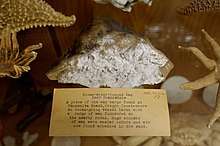Beeswax wreck
The beeswax wreck is an as-yet-undiscovered shipwreck somewhere off the coast of the U.S. state of Oregon, near Neahkahnie Mountain and the mouth of the Nehalem River in Tillamook County. The ship, thought to be a Spanish Manila galleon that was wrecked in the late-1600s, was carrying a large cargo of beeswax, lumps of which have been found scattered along Oregon's north coast for at least two centuries.

Early history
The earliest written reference to the wreck dates from 1813, when fur trader Alexander Henry, of Astoria, noted that the local Clatsop tribe had "great quantities of beeswax" to trade, which they told him had come from a shipwreck near Nehalem Bay.[1][2] Chunks of beeswax continued to be discovered along the shoreline throughout the 19th and 20th centuries, leading to much speculation about its origin. In the early 1900s, some scientists suggested, erroneously, that the substance was in fact a mineral residue left behind by petroleum which had been forced up to the surface from some underground reservoir – at least one drilling project was undertaken in the area on the basis of this theory.[3]
Identity
Although efforts to locate the wreck have so far met with no success, researchers have found clues to its identity in the debris that has washed ashore. In addition to the beeswax, teak timbers and shards of Chinese porcelain have been found, suggesting that the wreck is that of a Spanish Manila galleon, which would have made regular trips from Manila, Philippines, to Acapulco, Mexico, in the days of the Spanish Empire. Such ships were often constructed from teak, and would have been carrying luxury Chinese goods such as porcelain to trade[4] – along with beeswax, which would have been needed by churches in the Spanish colonies for making candles.[2] The theory is strengthened by the fact that much of the beeswax is marked with Spanish shipping symbols, and the wings of bees native to the Philippines have been found trapped inside the wax.[5] It is not known, however, why a Manila galleon would be sailing off the coast of Oregon, far north of the usual trade route; it is possible that it was disabled in a storm and drifted off course.[6]
By studying the designs on the porcelain shards, a team of researchers led by Scott Williams concluded in 2011 that the wreck must date from the late 17th century. According to the comprehensive records kept by the Spanish government of the time, only two Manila galleons went missing during that period – the Santo Christo de Burgos, in 1693, and the San Francisco Xavier, in 1705.[4] The San Francisco Xavier was initially considered the more likely candidate, partly because it was thought that a tsunami which struck the Oregon coast in 1700 would have destroyed any evidence of an earlier shipwreck;[7] however, after conducting further surveys, Williams' team now believes that the tsunami played a key role in dispersing the debris along the coastline, and that the wreck's true identity is therefore the Santo Christo de Burgos.[4] They also believe that the wreck is probably located further north than previously thought, close to Neahkahnie Mountain.[7]
In July 2018 a special issue of the Oregon Historical Quarterly was devoted to the wreck. Titled “Oregon's Manila Galleon", the issue features articles describing the ongoing research as of 2018. According to the issue's articles the galleon was probably the Santo Cristo de Burgos, voyage of 1693. Oral histories of the Tillamook and Clatsop are described, as well as the archaeology efforts and results as of 2018. Additional articles provide information about the crew, passengers, and cargo that was aboard the Santo Cristo.[8][9][10]
See also
- Cronin Point Site
- Augustus C. Kinney
- List of Oregon shipwrecks
- Chief Kilchis
References
- Tubbs, Stephenie Ambrose; Jenkinson, Clay (2015). The Lewis and Clark Companion. Henry Holt & Company. p. 23. ISBN 9781627796699.
- Williams, Scott. "Beeswax shipwreck". The Oregon Encyclopedia (Oregon Historical Society). Retrieved December 8, 2015.
- Cotton, S. J. (2013) [1915]. Gitzen, Garry (ed.). Stories of Nehalem. Lulu Press, Inc. pp. 58–61. ISBN 9781257550487.
- Knecht, Robert Lewis (February 2, 2012). "Mystery of the 'Beeswax Wreck' in Nehalem Bay". Coast Explorer.
- "Beeswax from centuries-old shipwrecks still found on Oregon beaches". The Seattle Times. March 3, 2008.
- Tobias, Lori (August 14, 2013). "Search for centuries-old galleon off Oregon coast begins anew near Manzanita". The Oregonian.
- Williams, Scott (March 2008). "Report on 2007 Fieldwork of the Beeswax Wreck Project, Nehalem Bay, Tillamook County, Oregon" (PDF). The Beeswax Wreck Project.
- "Back Issues: Summer 2018 "Oregon's Manila Galleon"". Oregon Historical Society. Retrieved 23 October 2019.
- La Follette, Cameron; Deur, Douglas; Griffin, Dennis; Williams, Scott S. (July 2018). "Oregon's Manila Galleon". Oregon Historical Quarterly. Oregon Historical Society. 119 (2): 150–159. doi:10.5403/oregonhistq.119.2.0150.
- La Follette, Cameron; Deur, Douglas (July 2018). "Views Across the Pacific: The Galleon Trade and Its Traces in Oregon". Oregon Historical Quarterly. Oregon Historical Society. 119 (2): 160–191. doi:10.5403/oregonhistq.119.2.0160. Retrieved 23 October 2019.
Further reading
- Clarke, S. A. (1905). "Wrecked beeswax and buried treasure". Pioneer Days of Oregon History. J. K. Gill Company. pp. 168–176.
- Williams, Scott S. (2016). "Chapter 8: The Beeswax Wreck, A Manila Galleon in Oregon, USA". In Wu, Chunming (ed.). Early Navigation in the Asia-Pacific Region: A Maritime Archaeological Perspective. Springer. pp. 146–168. ISBN 978-981-10-0904-4. Retrieved 23 October 2019.
External links
- La Follette, Cameron. "Santo Cristo de Burgos: An Essay". The Oregon Encyclopedia. Oregon Historical Society. Retrieved 23 October 2019.
- "Beeswax Wreck Project". Maritime Archaeology Society. Retrieved 23 October 2019.